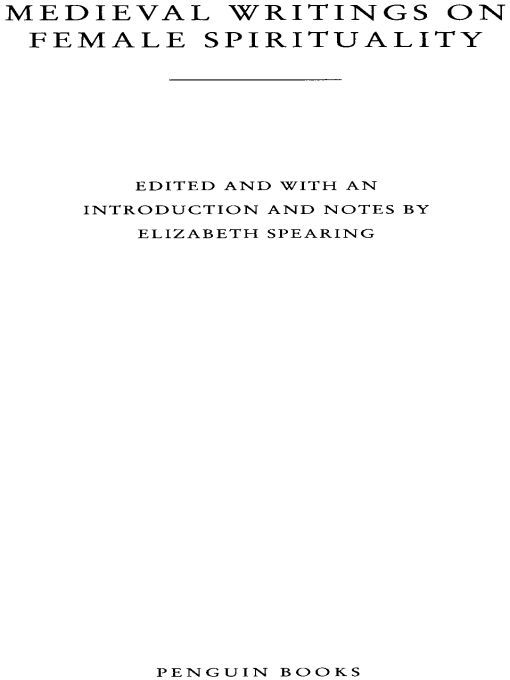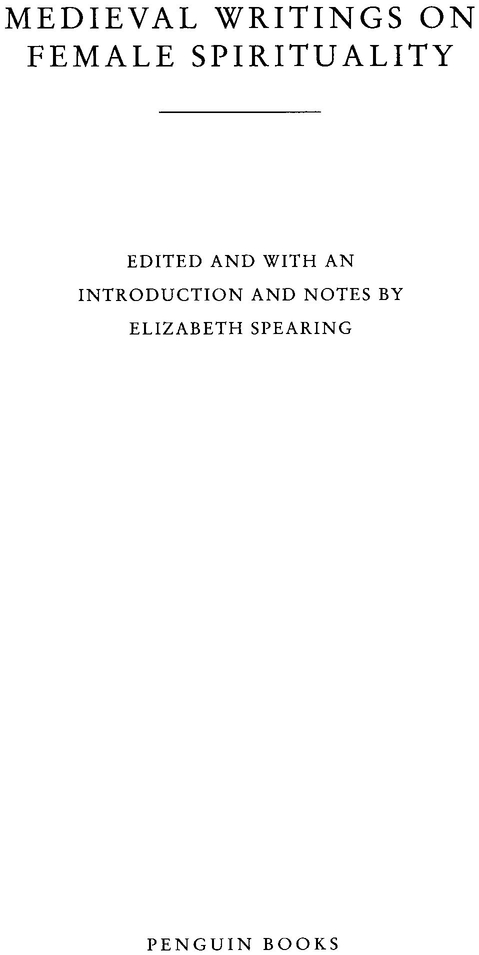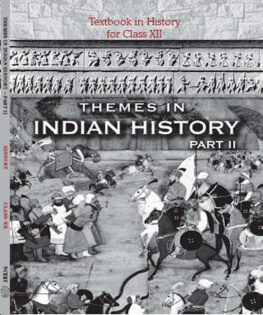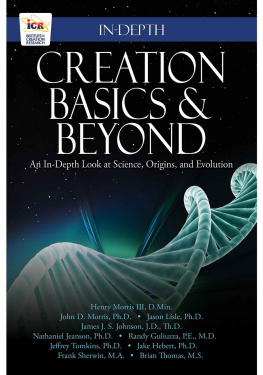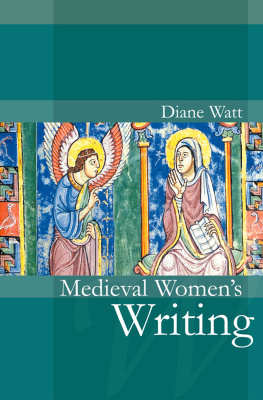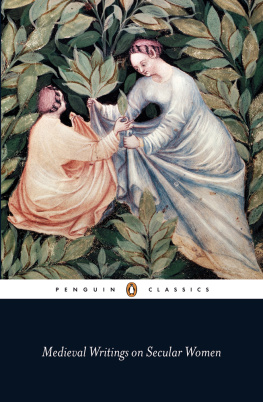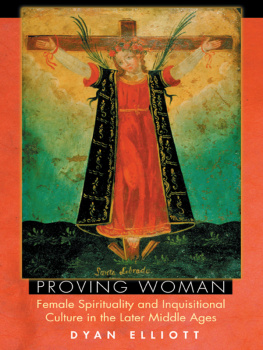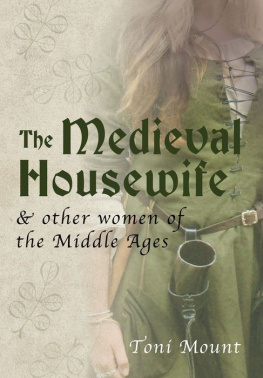Table of Contents
MEDIEVAL WRITINGS ON FEMALE SPIRITUALITY
Elizabeth Spearing holds a D.Phil. from the University of York. She has published articles on the Amadis cycle and on Aphra Behn, and she translated Julian of Norwichs Revelations of Divine Love for Penguin Classics. With A.C. Spearing (who wrote the introduction and notes to Revelations), she has collaborated on editions of Chaucers Reeves Tale, Shakespeares The Tempest, and the anthology Poetry in the Age of Chaucer.
INTRODUCTION
This volume offers a selection from some of the great variety of writing by and about religious women in the Middle Ages. The focus is on such writing in northern Europe, especially texts which were available in English, either because that was the language in which they were written or because English versions of them had been made. The choice of texts is deliberately widevaried in period, purpose, and quality. It includes the visions of an aristocratic prophet, those of a narrow-minded and malicious nun, and a profoundly original exploration of the nature of God. When these women lived it was not normal for anyone who was reasonably rich, no matter how literate, to do their own writingthere would always be someone on hand to do it for themnor were all the women in this selection literate. Some of the texts, it is true, present themselves as first-person writings by women themselveswhether poems, letters, meditations, or visionsbut many are third-person accounts by men of the lives and practices of women regarded as holy.
Even in what may seem to be moments of the most direct self-expression, the writings are shaped by a variety of literary conventions. Some are poetic compositions, including letters, which draw on the tradition of courtliness. Some belong to the field of mysticism in its fullest sensereligious experience directed towards the souls union with God in this life. Some are prophetic in ways that recall the prophets of the Old Testament and the Apocalypse. Some are visionary writings at a less exalted level, belonging to a tradition that goes back through the early centuries of Christianity to the Biblevisions of heaven and hell, and especially of purgatory, the only place from which spirits could reappear on earth to confirm the Churchs teaching about the efficacy of prayer, comforting for laypeople and remunerative for the Church. Some are meditations on Christs human life, from passionate imaginings of the Crucifixion to Margery Kempe seeing herself as a servant in St. Annes household and caring for the Virgin in her childhood. Some are accounts by men of womens attempts to imitate Christ and purge sin through various kinds of bodily suffering; they often involve extreme kinds of self-mortification and seem bizarre by modern standards. Some will probably convince most readers of the authenticity of their strivings towards the transcendent. In others there are elements of fantasy and even comfortable self-deception: punishment is promised for enemies, heaven for friends and family. It is revealed to St. Bridget that her daughter would be more useful with her mother in Rome than with her husband in Sweden, and there are a number of instances of critics of a visionary coming to unpleasant ends after she has complained to God: That jangling cleric is too proud of his learning to want me. But I shall give him a clout and he will really know that I am God. And shortly after that he died of the palsy.
From the beginnings of Christianity there had been deep suspicion of religious teaching by women. St. Pauls severe prohibitions were frequently repeated: Let women keep silence in the churches; for it is not permitted them to speak, but to be subject [1Cor 14:34], and Nor I suffer not a woman to speak, but to be subject [1Ti 2:12]. Many of the women in this collection lay claim to elevated religious insights, and yet they themselves and the men who write about them feel obliged to present them in terms of modesty and humility. Thus we are told that Mary of Oignies was always modest and as simple as a dove in every way, and even Hildegard of Bingen, a great aristocratic lady who did not hesitate to denounce the leaders of the Church, felt obliged to describe herself as a poor little creature. In the case of Margery Kempe, whose impact on others is a central theme of her book, hostility was aroused not just by her eccentricity but by the simple fact that she was a woman who dared to make public pronouncements about religious matters. Literacy was far less common among women than among men. Women who could read and write could usually do so only in the vernacular languages ; very few learned Latin, the language of the Bible and the liturgy (Hildegard and Bridget were among the exceptions), and this meant that they were cut off from the world of learning and abstract thought and especially of theology. This put them at a great disadvantage but could also be an advantage to them. They could be more individual, more peculiar, and they could think in ways which were not bound by the rigid logic of scholasticismand might more often be left alone to do so. Julian might not have got away with some of the things she wrote if she had been a man writing in Latin.
The survival and diffusion of texts before printing was dependent on a few people and local circumstances, and this was particularly likely to be true of women. Which women became well-known and widely-read must have depended not just on the value and interest of what they thought and experienced, but on which male clerics admired them and whether the womens teachings and ways of life were what the contemporary Church wanted to encourage. Bridget of Sweden, who lived in Rome for the last twenty-five years of her life, reiterated and expanded orthodox views; she had a direct connection with the papacy and was recognized and canonized soon after her death. However, though the Church could be very effective at promoting the works of women it approved, it could not always control the writing of such people as Marguerite Porete: she was not canonized, but burned at the stake. Our access to the women in this volume is through men; even texts that are almost certainly written by the woman herself owe their continued existence to a male scribe, and some exist because of a succession of men. For some women, a male cleric was not just the authorizer but the author of her text. Elizabeth of Spaalbeek had first to be recognized as peculiarly holy by senior churchmen in her area; at the bishops request, a local abbot, her cousin, became her protector. This man did not just provide for her care; Elizabeth enacted a religious drama through the hours of the day and night, and her reverend cousin presented the performance to admiring visitors, selecting and interpreting her behaviour as he did so: This reverend abbot ... was with us during everything which I have described and was our informant and reliable expounder of the virgins words, declares Philip, the monk from Clairvaux who wrote a Latin account of her life in which he also refers at intervals to worthy men who had added to his own first-hand knowledge. Before a medieval Englishwoman could read this account of Elizabeths life, an unknown English cleric had to translate Philips Latin, sometimes having trouble understanding it, cutting selectively as he went along.

